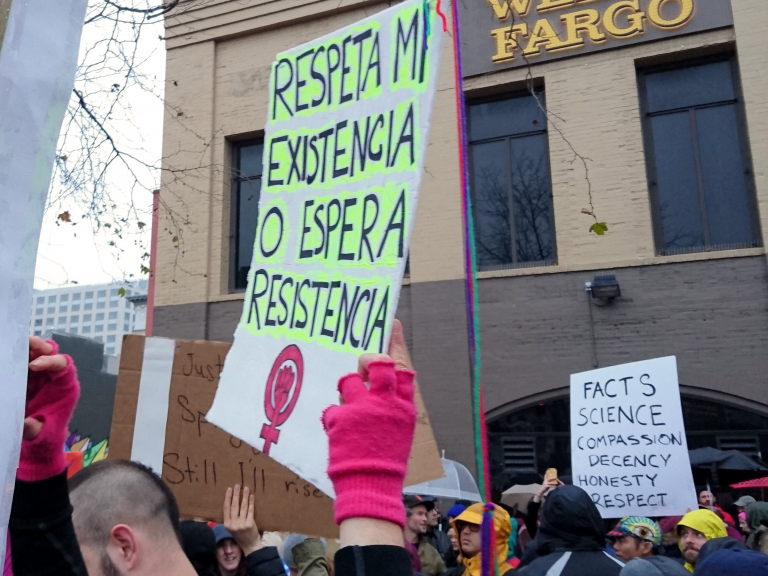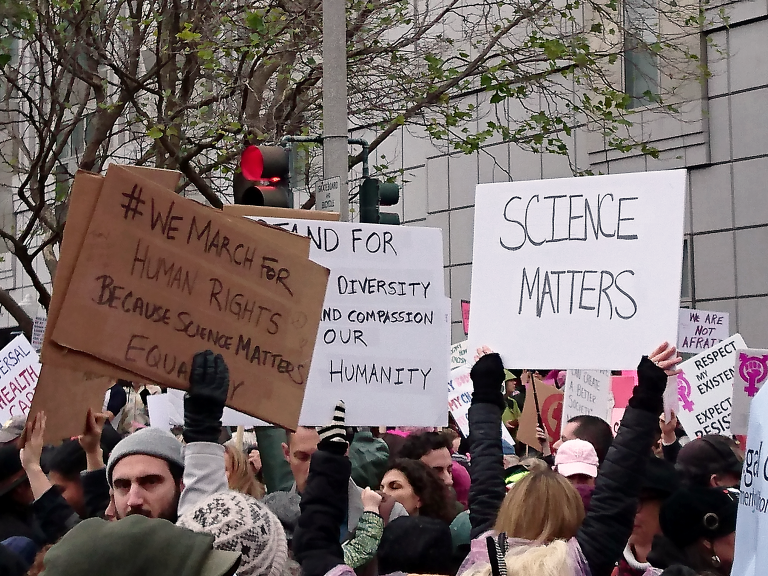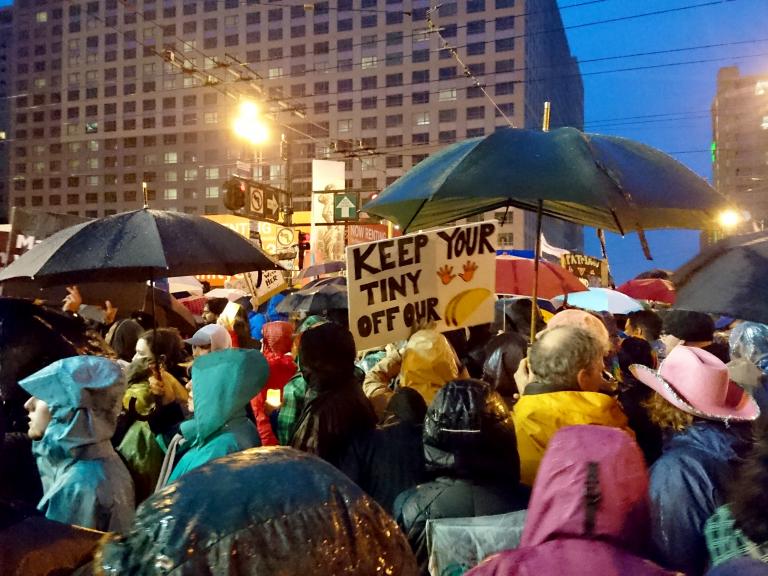By: Patrick W. Zimmerman

Not her president.
(Photo by author)
The massive turnout around the country (and parts of the globe) for the Woman’s March on Saturday surpassed all expectations. It became immediately evident that it was not simply a march in defiance of the threat represented by the new Misogynist in Chief to the very concept of sexual equality, but rather a public outlet for every group that feels threatened by the rise of white nationalism. It was a march of women announcing that they had no intention of giving up their (very) hard-won freedoms of the past century.
But, comingled with that, the sea of millions of women also provided a vehicle for posters, signs and chants from LGBT activists, environmentalists, immigrants, science advocates, and other normal decent humans appalled at the likely agenda of the new administration. Sprinkled in among the “Pussy Grabs Back” posters thrust up into the damp San Francisco sky, I counted significant minorities citing everything from the Torah to SCIENCE! to the number of Twitter tantrums thrown by the new President. For one afternoon, at least, feminism overlapped and blended with immigrant rights, anti-corruption calls, environmentalism, and the academe.
The short-short version
Given a first chance to protest during Trump’s administration, pretty much everyone who wasn’t part of Trump’s Movement jumped at the chance. The March on Washington was expected to draw a crowd north of 200,000, and the actual turnout at least doubling that (estimates range from 470,000 attendees to 1 million) was mildly interesting. However, it was the rampant turnout across the country, in both big cities and small-to-medium sized towns that was really surprising.
Most shocking of all: the small-town solidarity. Looking at only small and medium-sized cities and towns, in metro areas of less than 1 million people, at least 626,848 people marched in protest in 425 events. That is to say, it is very likely more people marched in Women’s Marches outside of major metro areas than attended Trump’s inauguration. And that estimate is using the lowest estimates for march numbers to top a relatively generous estimate of the inauguration crowd (which could have been as low as 250,000 and most certainly could not have been as high as 1.5 million). Even that considerable block of people only represented 19% of the total number of marchers (between 3,160,653-4,687,648 in the US).

Yes, it does. Wishing does not make alternative facts true.
(Photo by author)
Small to medium cities and towns were the center of Trump’s rise to power. They formed the heart of Trumplandia, of the America that needed to be Made Great Again. And they represented nearly a fifth of the people so terrified by the 45th President that they came out to collectively scream at him. Those protesters alone doubled the largest gathering of Tea Party protesters in April 15, 2009. The low estimate for the total number of anti-Trump agitators was an order of magnitude higher than the most massive public expression of the movement co-opted by Trump. Suck on that, Donnie.
Notes on sources: this project is heavily indebted to Jeremy Pressman (UConn) and Erica Chenoweth (U Denver) and their amazingly awesome open-source public collection of march locations, estimates, and sources. All population data was collected from the US Census, 2015 estimates where possible, 2010 or 5-year estimates when not. For marches within a designated metro or micropolitan census area, the total for the area was used, except when in a metropolitan area with clear subdivisions (i.e. Newark, NJ was assigned the Newark segment of the NY-Newark metropolitan statistical area. San Francisco was credited with the Peninsula and Marin County, Oakland with the East Bay, etc.)
The Woman’s March in small-to-medium towns and cities
The quick takeaways
- A surprisingly high number of protesters marched in cities outside of the expected major metro areas (I used a metro area population of 1 million as a cutoff), 19%.
- 25% of the marchers did so in medium sized cities or less (less than 2 million in the immediate metro area), so all places Indianapolis or smaller.
- 4 cities had marches that may have been larger than the inauguration (Washington, LA, New York, and Chicago), meaning the high estimates for their Woman’s Marches were higher than the lowest estimates for the inauguration (250,000). Washington and New York quite likely were larger.
- The median-sized march city (50% of the marchers were in bigger metro areas, 50% smaller) was Seattle.
- All hail Twisp, WA. A town of 942 people had the equivalent of 85% of its population marching through its streets to reject Trump (800). Second place: Monhegan Island, ME, where 22 people were counted on an island with a population of 34.
- Demarcating the marches by % of population rather than by simple size of march exaggerates the participation level in smaller cities and more rural areas (because the surrounding population who could potentially attend is much harder to estimate than the defined metro and micropolitan statistical areas). However, it’s a very useful heuristic to show the surprising levels of protest outside the expected liberal bastions of urban America.
- It doesn’t take courage to join 400,000-500,000 like-minded people in New York City. Courage is the 2 Trump protesters in Helena, AR (population 11,109). Or the 24 people who marched in Corpus Christi, TX (population 459,422). One imagines they were not received with particularly friendly waves by spectators.
The big map, by % of population marching (low estimate)
The big map, by % of population marching (high estimate)
What next?
Correlations, correlations, correlations!
- Did march size increase with minority population (early returns: big honking “nope”).
- How about with percentage of Hillary voters? Maybe, just have to go and translate the zip-code based geo file for the march with the FIPS based geo file for Principally Uncertain’s election data.
- Does normalizing for weather change anything (it rained steadily in DC and poured in San Francisco, for example)?
Most importantly, keep an eye on follow up protests as well as Trump’s hinted-at plans to bring back military parades. Tracking and comparing attendance at both pro- and anti-Trump rallies looks like a going concern for the next four years.
Mr. President, you wanted center stage, so now everyone will be watching. Enjoy.

True taken literally and metaphorically.
(Photo by author)
Additional note: I owe a debt of gratitude to Lee Vinsel and the Maintainers for pointing out the Tea Party rally comparison. Also, for fomenting interesting debate, both with and without beer.
No Comments on "Breaking down the Women’s March: Even small-town marchers out-numbered the inauguration"